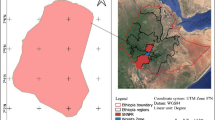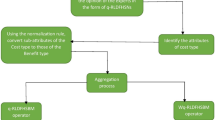Abstract
The recent boom of decision-making under uncertain information has attracted many researchers to the field of integrating various types of sets with decision-making methods. In this paper, a combined decision-making trial and evaluation laboratory (DEMATEL) with single-valued neutrosophic sets is proposed to solve the decision problem. This new model combines the advantages of multiplicative inverse of decision matrix in DEMATEL and neutrosophic numbers in linguistic variables, which can find the interrelationship among factors of decision problem. Differently from the typical multiplicative inverse of DEMATEL, which directly used inverse of matrix using real numbers, this method introduces the concept of inverse of matrix using the proposed left–right neutrosophic numbers. This step will enhance the validity of multiplicative inverse of decision matrix in the DEMATEL with neutrosophic numbers. The proposed neutrosophic DEMATEL is also be compared with the DEMATEL and fuzzy DEMATEL. This paper includes a case study that demonstrates the applicability of the neutrosophic DEMATEL in establishing the relationship among influential factors of coastal erosion. Extensive empirical studies using 12 factors of coastal erosion were presented to study the benefits of the proposed method. The result unveils the cause-and-effect relationships among the factors, where seven factors are identified as cause factors and five factors are grouped as effect factors. It is discovered that the factor ‘imbalance sediment supply’ gives a significant influence to coastal erosion. It is also shown that the degree of importance of the factors is almost consistent with the other two methods despite differences in type of numbers used in defining linguistic variables.


Similar content being viewed by others
References
Abdel-Basset M, Manogaran G, Gamal A, Smarandache F (2018) A hybrid approach of neutrosophic sets and DEMATEL method for developing supplier selection criteria. Des Autom Embed Syst 22(3):257–278
Abdullah L, Zulkifli N (2015) Integration of fuzzy AHP and interval type-2 fuzzy DEMATEL: an application to human resource management. Expert Syst Appl 42(9):4397–4409
Abdullah L, Zulkifli N (2019) A new DEMATEL method based on interval type-2 fuzzy sets for developing causal relationship of knowledge management criteria. Neural Comput Appl 31(8):4095–4111
Alam-Tabriz A, Rajabani N, Farrokh M (2014) An integrated fuzzy DEMATEL-ANP-TOPSIS methodology for supplier selection problem. Glob J Manag Stud Res 1(2):85–99
Awang A, Aizam N, Abdullah L (2019) An integrated decision-making method based on neutrosophic numbers for investigating factors of coastal erosion. Symmetry 11(3):328
Baykasoğlu A, Kaplanoğlu V, Durmuşoğlu Z, Şahin C (2013) Integrating fuzzy DEMATEL and fuzzy hierarchical TOPSIS methods for truck selection. Expert Syst Appl 40(3):899–907
Biswas P, Pramanik S, Giri B (2015) TOPSIS method for multi-attribute group decision-making under single-valued neutrosophic environment. Neural Comput Appl 27(3):727–737
Büyüközkan G, Çifçi G (2012) A novel hybrid MCDM approach based on fuzzy DEMATEL, fuzzy ANP and fuzzy TOPSIS to evaluate green suppliers. Expert Syst Appl 39(3):3000–3011
Can GF, Delice KE (2018) A task-based fuzzy integrated MCDM approach for shopping mall selection considering universal design criteria. Soft Comput 22(22):7377–7397
Cebi S (2013) A quality evaluation model for the design quality of online shopping websites. Electron Commer Res Appl 12(2):124–135
Chang B, Chang C, Wu C (2011) Fuzzy DEMATEL method for developing supplier selection criteria. Expert Syst Appl 38(3):1850–1858
Chen F, Hsu T, Tzeng G (2011) A balanced scorecard approach to establish a performance evaluation and relationship model for hot spring hotels based on a hybrid MCDM model combining DEMATEL and ANP. Int J Hosp Manag 30(4):908–932
Chirra S, Kumar D (2018) Evaluation of supply chain flexibility in automobile industry with fuzzy DEMATEL approach. Glob J Flex Syst Manag 19(4):305–319
Chou Y, Sun C, Yen H (2012) Evaluating the criteria for human resource for science and technology (HRST) based on an integrated fuzzy AHP and fuzzy DEMATEL approach. Appl Soft Comput 12(1):64–71
Dehghan M, Ghatee M, Hashemi B (2007) Inverse of a fuzzy matrix of fuzzy numbers. Int J Comput Math 86(8):1433–1452
Dubois D, Prade H (1978) Operations on fuzzy numbers. Int J Syst Sci 9(6):613–626
Fritze A, Mönks U, Lohweg V (2016) A support system for sensor and information fusion system design. Procedia Technol 26:580–587
González-Ferrer A, Seara G, Cháfer J, Mayol J (2017) Generating big data sets from knowledge-based decision support systems to pursue value-based healthcare. Int J Interact Multimedia Artif Intell 4(7):42–46
Hsu CY, Kuo KT, Chen S, Hu A (2013) Using DEMATEL to develop a carbon management model of supplier selection in green supply chain management. J Clean Prod 56:164–172
Jassbi J, Mohamadnejad F, Nasrollahzadeh H (2011) A fuzzy DEMATEL framework for modeling cause and effect relationships of strategy map. Expert Syst Appl 38(5):5967–5973
Ji P, Wang JQ, Zhang HY (2018) Frank prioritized Bonferroni mean operator with single-valued neutrosophic sets and its application in selecting third-party logistics providers. Neural Comput Appl 30(3):799–823
Karaşan A, Kaya İ, Erdoğan M (2018) Location selection of electric vehicles charging stations by using a fuzzy MCDM method: a case study in Turkey. Neural Comput Appl. https://doi.org/10.1007/s00521-018-3752-2
Lin C, Wu W (2008) A causal analytical method for group decision-making under fuzzy environment. Expert Syst Appl 34(1):205–213
Lin LK, Den W, Chou Y, Yen H, Lu C (2015) A study on developing the indicators of energy conservation and carbon reduction for the business. In: IEEE international conference on industrial engineering and engineering management, pp 1491–1495
Liou JJ, Tzeng GH, Chang HC (2007) Airline safety measurement using a hybrid model. J Air Transp Manag 13(4):243–249
Liu P, Wang Y (2014) Multiple attribute decision-making method based on single-valued neutrosophic normalized weighted Bonferroni mean. Neural Comput Appl 25(7–8):2001–2010
Liu H, You J, Lin Q, Li H (2014) Risk assessment in system FMEA combining fuzzy weighted average with fuzzy decision-making trial and evaluation laboratory. Int J Comput Integr Manuf 28(7):701–714
Luo S, Wang H, Cai F (2013) An integrated risk assessment of coastal erosion based on fuzzy set theory along Fujian coast, southeast China. Ocean Coast Manag 84:68–76
Majumdar P, Samanta SK (2014) On similarity and entropy of neutrosophic sets. J Intell Fuzzy Syst 26(3):1245–1252
Morente-Molinera JA, Ríos-Aguilar S, González-Crespo R (2019) Dealing with group decision-making environments that have a high amount of alternatives using card-sorting techniques. Expert Syst Appl 127:187–198
Pandey A, Kumar A (2017) Commentary on “Evaluating the criteria for human resource for science and technology (HRST) based on an integrated fuzzy AHP and fuzzy DEMATEL approach”. Appl Soft Comput 51:351–352
Peng JJ, Wang JQ, Wu X, Wang J, Chen X (2014) Multi-valued neutrosophic sets and power aggregation operators with their applications in multi-criteria group decision-making problems. Int J Comput Intell Syst 8(2):345–363
Peng JJ, Wang JQ, Wang J, Zhang H, Chen XH (2015) Simplified neutrosophic sets and their applications in multi-criteria group decision-making problems. Int J Syst Sci 47(10):2342–2358
Poole D (2006) Linear algebra: a modern introduction. Thompson Brooks/Cole, Belmont
Roy B, Misra SK, Gupta P, Neha AG (2012) An integrated DEMATEL and AHP approach for personnel estimation. IJCSITS 2:1206–1212
Şahin R, Küçük A (2015) Subsethood measure for single valued neutrosophic sets. J Intell Fuzzy Syst 29(2):525–530
Şahin R, Liu P (2015) Maximizing deviation method for neutrosophic multiple attribute decision making with incomplete weight information. Neural Comput Appl 27(7):2017–2029
Sara J, Stikkelman RM, Herder PM (2015) Assessing relative importance and mutual influence of barriers for CCS deployment of the ROAD project using AHP and DEMATEL methods. Int J Greenhouse Gas Control 41:336–357
Shen Y, Lin G, Tzeng G (2011) Combined DEMATEL techniques with novel MCDM for the organic light emitting diode technology selection. Expert Syst Appl 38(3):1468–1481
Shieh J, Wu H, Huang K (2010) A DEMATEL method in identifying key success factors of hospital service quality. Knowl-Based Syst 23(3):277–282
Smarandache F (1999) A unifying field in logics: neutrosophy: neutrosophic probability, set and logic. American Research Press, Rehoboth
Tsai W, Hsu W (2010) A novel hybrid model based on DEMATEL and ANP for selecting cost of quality model development. Total Qual Manag Bus Excell 21(4):439–456
Wang Y, Tzeng G (2012) Brand marketing for creating brand value based on a MCDM model combining DEMATEL with ANP and VIKOR methods. Expert Syst Appl 39(5):5600–5615
Wang H, Smarandache FY, Zhang Q, Sunderraman R (2005) Interval neutrosophic sets and logic: theory and applications in computing. Hexis, Phoenix
Wang H, Smarandache FY, Zhang Q, Sunderraman R (2010) Single valued neutrosophic sets. Multispace Multistruct 4:410–413
Wang J, Yang Y, Li L (2018) Multi-criteria decision-making method based on single-valued neutrosophic linguistic Maclaurin symmetric mean operators. Neural Comput Appl 30:1529
Ye J (2013) Multicriteria decision-making method using the correlation coefficient under single-valued neutrosophic environment. Int J Gen Syst 42(4):386–394
Ye J (2014) A multicriteria decision-making method using aggregation operators for simplified neutrosophic sets. J Intell Fuzzy Syst 26(5):2459–2466
Acknowledgements
This study was funded by Niche Research Grant Scheme (NRGS 53131/9), and Talent and Publication Enhancement-Research Grant (TAPE-RG 55155), and Fundamental Research Grant Scheme (FGRS 59522), Universiti Malaysia Terengganu, Ministry of Higher Education.
Author information
Authors and Affiliations
Corresponding author
Ethics declarations
Conflict of interest
The authors declare that they have no conflict of interest.
Additional information
Communicated by V. Loia.
Publisher's Note
Springer Nature remains neutral with regard to jurisdictional claims in published maps and institutional affiliations.
Appendix A
Appendix A
Theorem
Consider the nonnegative SVNS matrix \( \tilde{A} = \left( {\left\langle {\tilde{T},\tilde{I},\tilde{F}} \right\rangle } \right)_{n \times n} \) and let \( \tilde{A} \) be the element of the class of all nonnegative matrices with nonnegative inverses. Moreover, suppose that \( \tilde{F}_{ij} = 0 \) if \( \tilde{T}_{ij} \) is zero; then,
is the left \( \varepsilon \)-inverse of \( \tilde{A} \), where \( \varepsilon > 0 \) is chosen in the following interval,
This theorem can be proved using the concept of inverse matrix, \( \tilde{A} \times \tilde{B} = I \), where \( \tilde{B} \) is the inverse of \( \tilde{A} \).
Proof
We must prove
Based on the above assumption on \( \varepsilon \), the SVNS matrix
is positive. Thus, it can be rewritten as
Or equivalently
which is a valid system. □
Rights and permissions
About this article
Cite this article
Awang, A., Abdullah, L., Ab Ghani, A.T. et al. A fusion of decision-making method and neutrosophic linguistic considering multiplicative inverse matrix for coastal erosion problem. Soft Comput 24, 9595–9609 (2020). https://doi.org/10.1007/s00500-019-04467-5
Published:
Issue Date:
DOI: https://doi.org/10.1007/s00500-019-04467-5




